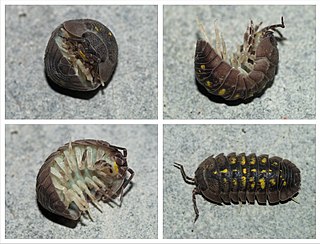
Armadillidium is a genus of the small terrestrial crustacean known as the woodlouse. Armadillidium are also commonly known as pill woodlice, leg pebbles, pill bugs, roly-poly, or potato bugs, and are often confused with pill millipedes such as Glomeris marginata. They are characterised by their ability to roll into a ball ("volvation") when disturbed.

Philosciidae are a family of woodlice. They occur almost everywhere on earth, with most species found in (sub)tropical America, Africa and Oceania, and only a few in the Holarctic.

Porcellionides is a genus of woodlice in the family Porcellionidae. It includes the following species :

Hemilepistus is a genus of woodlice, created by G. H. A. Budde-Lund in 1879 as a subgenus of Porcellio, but raised to the rank of genus by Karl Wilhelm Verhoeff in 1930. It contains the following species:

Trachelipus is a genus of woodlice in the family Trachelipodidae, containing the following species:

Belostoma is a genus of insects in the hemipteran family Belostomatidae, known colloquially as giant water bugs. Members of this genus are native to freshwater habitats in the Americas, with the greatest species richness in tropical South America. Most species in the family Belostomatidae have historically been included in Belostoma, but several of these have been moved to other genera.

Armadillidae is a family of woodlice, comprising around 80 genera and 700 species. It is the largest family of Oniscidea, and one of the most species-rich families of the entire Isopoda. Armadillids generally have a strongly convex body shape, with some rather shallowly convex. Like members of the woodlice family Armadillidiidae, armadillids are capable of enrolling into a sphere (conglobation), and are commonly known as pill bugs. Armadillids differ from the Armadillidiidae in that the antennae are fully enclosed within the sphere.

Armadillidium nasatum is a large, Britain-based species of woodlouse that has been introduced to North America, along with Armadillidium vulgare also found in other parts of Europe.

Niambia is a genus of woodlice in the family Platyarthridae. There are at least 20 described species in Niambia.
Rhyscotus is a genus of armadillo woodlice, land crustacean isopods of the family Rhyscotidae. It was first described in 1885 by Gustav Budde-Lund.

Glyptoscelis is a genus of leaf beetles in the subfamily Eumolpinae. There are 38 species of Glyptoscelis described from North, Central and South America. There are also three species of Glyptoscelis known from the West Indies, though they are wrongly placed in the genus. In addition, a single species was described from Hunan, China in 2021.
Alloniscus is the sole genus in the woodlice family Alloniscidae. There are more than 20 described species in Alloniscus.

Armadilloniscus is a genus of woodlice in the family Detonidae. There are more than 30 described species in Armadilloniscus.

Platyarthrus is a genus of woodlice in the family Platyarthridae. There are more than 30 described species in Platyarthrus.

Sparnopolius is a genus of bee flies, insects in the family Bombyliidae. There are about 17 described species in Sparnopolius.

Sacodes is a genus of marsh beetles in the family Scirtidae. There are about seven described species in Sacodes.

Cylisticus is a genus of woodlice in the family Cylisticidae. There are at least 70 described species in Cylisticus.

Philoscia is a genus of woodlice in the family Philosciidae. There are more than 80 described species in Philoscia.

















